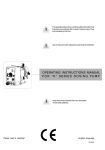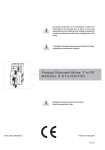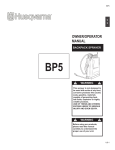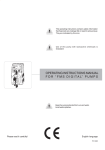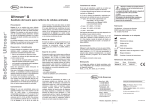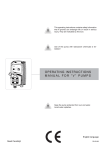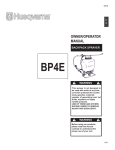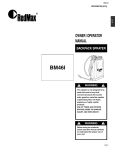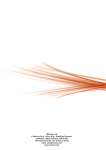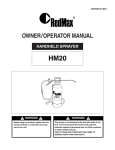Download OPERATING INSTRUCTIONS MANUAL FOR “G” SOLENOID
Transcript
This operating instructions contains safety information that if ignored can endanger life or result in serious injury. They are indicated by this icon. Use of this pump with radioactive chemicals is forbidden! OPERATING INSTRUCTIONS MANUAL FOR “G” SOLENOID DOSING PUMP Keep the pump protected from sun and water. Avoid water splashes. Please read it carefully! English language “G” Series Dosing Pump Maintenance and Installation Manual R1-02-04 1 «CE» referring norms “G Analog” series dosing pumps comply with the following European regulations: EN60335-1 : 1995, EN55014, EN50081-1/2, EN50082-1/2, EN6055-2, EN60555,3 Based on directive CEE 73/23 c 93/68 (DBT Low voltage directive) and directive 89/336/CEE (EMC Electromagnetic Compatibility) All metering pumps supplied with 115 VAC are available with certification CSA. All metering pumps with 230 VAC and 115 VAC power supply with FP o-rings are listed NSF 50 (except for 00 100 models). GENERAL SAFETY GUIDELINES Danger! In emergencies the pump should be switched off immediately! Disconnect the power cable from the power supply! When using pumps with aggressive chemicals observe the regulations concerning the transport and storage of aggressive fluids! When installing outside European Community, always observe national regulations! Manufacturer is not liable for any unauthorized use or misuse of this product that can cause injury or damage to persons or materials! Caution! Pumps must be accessible at all times for both operating and servicing. Access must not be obstructed in any way! Feeder should be interlocked with a no-flow protection device to automatically shutoff the pump when there is no flow! Pumps and accessories must be serviced and repaired by qualified and authorized personnel only! Always discharge the liquid end before servicing the pump! Empty and rinse the liquid end before work on a pump which has been used with hazardous or unknown chemicals! Always read chemical safety datasheet! Always wear protective clothing when handling hazardous or unknown chemicals! 2 “G” Series Dosing Pump Maintenance and Installation Manual Index GENERAL INFORMATION .................................................................................................. 4 INSTALLATION .................................................................................................................... 4 PRIMING .............................................................................................................................. 5 METERING .......................................................................................................................... 5 ELECTRICAL WIRING ......................................................................................................... 5 ELECTRICAL PROTECTION ............................................................................................... 7 LEVEL ALARM ..................................................................................................................... 7 PUMP TYPES ...................................................................................................................... 7 MAINTENANCE ............................................................................................................... 11 REPAIR ............................................................................................................................. 11 QUICK TROUBLESHOOTING GUIDE ............................................................................. 11 O-RINGS ........................................................................................................................... 12 TECHNICAL FEATURES ................................................................................................. 12 CONSTRUCTION MATERIALS ........................................................................................ 12 ACCESSORIES ................................................................................................................ 13 PRINTED CIRCUIT BOARD CONNECTIONS ................................................................. 14 DELIVERY CURVES ......................................................................................................... 15 INSTALLATION DRAWING .............................................................................................. 18 EXPLODED VIEW ............................................................................................................. 24 “G” SERIES PHYSICAL DIMENSIONS ............................................................................ 25 SELF-VENTING PUMP HEAD .......................................................................................... 27 Technical features and drawings are subject to changes and modifications without any advice. “G” Series Dosing Pump Maintenance and Installation Manual 3 GENERAL INFORMATION “G” series magnetic diaphragm dosing pumps fits small and medium dosing amounts of liquid products. They are constituted of the following main assemblies: Box Electronic Circuitry Electrical Driven Magnet Diaphragm Pump Head The pump working mode is intermittent: a magnetic field is created each time a pulse reaches the magnet. The magnetic field pushes the piston. A diaphragm (fixed on the piston head) compresses the liquid into the pump head. The liquid gets out through the delivery valves while the suction valves close. When the pulse ends, a spring takes back the piston and the diaphragm. The vacuum created by the diaphragm movement takes the liquid inside the pump head from the suction valve, while the delivery valve is closed. The pump capacity is proportional to the number of strokes and to the pump head internal volume (Single Stroke Injection Quantity). Box “G” series dosing pumps are assembled in IP65 (PP) plastic material boxes. Installation is vertical with two screws at a distance of 152mm. Electronic Circuit The electronic circuit is made of proved quality components. It provides the necessary electrical pulses to the magnet. Electro-Magnet The electro-magnet with class H (180°C) copper winding, driven by the electronic circuit, gives the necessary push to the piston and the diaphragm. The piston displacement range is from 0.7mm to 1.7mm Diaphragm PTFE diaphragms used in the “G” series pumps assure good chemical compatibility and mechanical resistance. Pump Head The pump head diameters used in the “G” series pump are: ø22, ø32, ø44, ø58, ø64. The pump head works as a dosing chamber, the suction valve, delivery and manual outgassing valves are inside it. The purpose of the manual outgassing valve is to help the priming of the pump during installation. INSTALLATION The pump is supplied with all the materials needed for the installation. To set up the “G” series pump, first mount it on a wall or any other vertical surface in a well aerated and easily accessible environment. The distance between the pump head and the suction filter should not be more than 1.5m. Connect the suction pipe (transparent one) to the suction fittings (bottom pump head valve). Be sure the o-ring in the suction valve is in place. Use the hands to tight the fitting nut. Place the suction filter on the bottom of the product tank. The suction pipe should be as short as possible in vertical position without any bends to avoid air bubbles. Install the injection valve. Connect one end of the delivery pipe (opaque one) to the delivery fitting on the top of the pump head and the other end to the injection valve previously installed. 4 “G” Series Dosing Pump Maintenance and Installation Manual To avoid delivery pipe breaking be sure it does not touch any other object. Always install the injection valve at the end of the rigid delivery hose. The injection valve should never be installed lower then the product tank to avoid that injection valve breaking lets the product flow freely into the system. If the only way to install the injection valve is lower than the tank, then it is recommended to use an anti-syphon valve on the delivery side. This valve prevents vacuum on the pump. Feeder should be interlocked with a no-flow protection device to automatically shut-off the pump when there is no flow. Check regularly the delivery valve and immediately change it if inoperable or broken. Do not install tanks with chemical beneath: vapours may damage the pump. FREE END OF SUCTION HOSE SHOULD BE INSERTED JUST ABOVE THE BASE OF NOOZLE! USE ONLY HOSES COMPATIBLES WITH PRODUCT TO DOSE. PLEASE REFERS TO OUR “CHEMICAL COMPATIBILITY TABLE” ! PRIMING To prime the pump without touching chemicals please do as follow: - connect all hoses into proper places (delivery hose, suction hose, outgassing hose). - open outgassing valve and turn on the pump. - set pump’s single injection at 100% and pulses at 50%. All air inside the pump head will exit through the outgassing outlet. When product will leak from it, close immediately the outgassing valve. If dosing product is particularly dense, to facilitate the priming, insert on vent pipe a syringe of 20 cc and suck inside. METERING The “G” series pump technical features are printed on a label located at the left side of pump box. They include: power supply, working counterpressure (Kpa/bar) and pump capacity in liter per hour (l/h). All these dosing information are calculated by dosing water at 20 °C temperature, at the maximum counterpressure reported on the label, using the injection valve and the % knob set to maximum. Dosing accuracy is ± 2% l/h at constant maximum counterpressure and 1 cps flow (max viscosity: 60 cps). Caution: injection capacity is a constant value but a variation in counterpressure or product’s viscosity may cause some changes. For further details see “Delivery curves” paragraph. ELECTRICAL WIRING Pump has to be connected to power supply using the standard “SCHUKO” plug supplied or the special power supply cable. Before starting any electrical connection perform the following operations: - ensure a correct ground installation; - if there is a bad ground, install a differential switch with high sensibility (0,03 A) “G” Series Dosing Pump Maintenance and Installation Manual 5 as additional protection from electric shocks; - check that pump voltage corresponds to supply voltage; - connect ground before any other connection. Electrical features: Power supply range for 230 VAC models Power supply range for 115 VAC models Frequency 50÷ 60 Hz 198÷242 VAC 99÷121 VAC Model Pump “G” Consumption at 230 VAC and Fuse Value Consumption at 115 VAC and Fuse Value Gxx Gxx Gxx Gxx Gxx Gxx Gxx Gxx Gxx Gxx Gxx Gxx Gxx Gxx Gxx Gxx Gxx Gxx 230 VAC / 500 mA 230 VAC / 800 mA 230 VAC / 500 mA 230 VAC / 500 mA 230 VAC / 500 mA 230 VAC / 800 mA 230 VAC / 800 mA 230 VAC / 800 mA 230 VAC / 500 mA 230 VAC / 500 mA 230 VAC / 800 mA 230 VAC / 800 mA 230 VAC / 800 mA 230 VAC / 500 mA 230 VAC / 500 mA 230 VAC / 800 mA 230 VAC / 800 mA 230 VAC / 800 mA 115 VAC / 800mA 115 VAC / 630mA 115 VAC / 800mA 115 VAC / 800mA 115 VAC / 800mA 115 VAC / 800mA 115 VAC / 630mA 115 VAC / 630mA 115 VAC / 800mA 115 VAC / 800mA 115 VAC / 630mA 115 VAC / 630mA 115 VAC / 630mA 115 VAC / 800mA 115 VAC / 800mA 115 VAC / 800mA 115 VAC / 800mA 115 VAC / 800mA 00 100 01 15 01 50 03 30 04 20 05 10 07 07 10 05 10 10 12 07 15 03 18 02 20 01 20 05 05 15 03 10 01 15 18 04 27W 22W 27W 27W 27W 22W 22W 22W 27W 27W 22W 22W 22W 27W 27W 22W 22W 22W 21W 15W 21W 21W 21W 21W 15W 21W 21W 21W 15W 15W 15W 21W 21W 21W 21W 21W Pump power “on” is confirmed with a green led on the frontal panel. Do not connect the pump in parallel to an inductance load, like motors, to prevent electronic circuitry damages. Always use a connector to cut off spikes due to other devices switching. Dosing pump in parallel connection with inductive loads P - Metering Pump R - Relay I - Connector or Multi-Pole Safety Device E - Inductance Load A - Power Supply 6 “G” Series Dosing Pump Maintenance and Installation Manual ELECTRICAL PROTECTION Internal circuitry is protected against noises using the EMC system and with a fuse located under the front cover of the pump. To replace the fuse (trained personnel only) do as follow: - unplug power supply remove the 6 screws on the back cover of the pump replace fuse, use only approved fuses reported in table below put back cover in place, take care of seal position Each pump type fuse (5x20) T(delayed) can be found in the table on page 6: fig. 1 Pump “G” type are equipped with overvoltage protection (working voltages: 300 V, 150V, 39V), and a voltage peek protection up to 4 KV, 50 µsec against pulses like in fig. 1 REPAIRS MUST BE PERFORMED BY AUTHORIZED PERSONNEL ONLY. LEVEL ALARM CL, IS, IC, PV and TE type pump are provided with a liquid level alarm to indicate if product tank is empty. The level probe is connected to the extreme right BNC plug on pump’s bottom panel. The level probe output is made of a N.O. reed contact (10VA, 1A max., 230Vac max.) closed by a floating magnet housed in a (PP) plastic box. When the product level goes below the minimum the magnet closes the reed contact. The pump stops and the red LED on pump’s front panel indicates the alarm status. PUMP TYPES GCO type Constant dosing pump with stroke speed adjustment between 0 and 100% of indicated capacity (see label on pump type). The % marked knob sets the pump capacity, changing linearly the magnet stroke number per minute. It is strongly suggested to not operate the pump in the range from 0 to 10%, since there is not a linear correlation with the pump stroke speed in that range. This pump is specially designed for constant dosing rates. GCO pump can be ON/OFF driven by a LPH or a LCD instrument. To set 2.5 l/h against 5 bar on a GCO 0505 the % marked knob should be set to 50%. “G” Series Dosing Pump Maintenance and Installation Manual 7 GCL Constant dosing pump with level alarm, provided with a floating magnetic sensor probe. A red led indicates that the pump stopped dosing because the product tank is empty. This pump has the same features and adjustments of the CO type pump. GIC Proportional/constant pump driven by current signal. Setting the switch on the constant position the pump has the same features and adjustments of the CL pump. Setting the switch on the proportional position the pump capacity is set proportionally to a given analog current signal; a given signal linear change will be followed by a linear change of capacity. The current signal accepted range is 0÷20 mA (it can be changed upon demand). The maximum pump capacity requested by the maximum input signal is set by the % marked knob. The IC pump can be driven by any electronic device (such as pH-meter, redox-meter, etc) that gives an analog current signal output. This signal must be applied to the bipolar cable provided with the pump, already internal connected, taking care of connections: - red wire : positive (+) - black wire : negative (-) GIS Proportional/constant pump driven by a digital signal. Setting the switch on the constant position, the pump has the same features and adjustments of the CL pump. Setting the switch on the proportional position, to each external voltage free pulse correspond a magnet stroke. When proportional position is set, the % marked knob does NOT affect the pump capacity. IS proportional dosing pump can be driven by any external device (PCs, PLCs, etc) that produce a digital signal. The digital signal (N.O. contact) must be applied to the cable provided with the pump, already internal connected. If it is requested a 0÷5 ; 0÷12 Vdc input signal option take care of connections: - red wire : positive (+) - black wire : negative (-) GPV Proportional/constant pump driven by a water meter digital signal. Setting the switch on the constant position, the pump has the same features and adjustments of the CL pump. It is furthermore possible to divide the maximum magnet strokes per minute by 1, 10 and 100 using the switch on position, to each external pulse correspond the front panel. Setting the switch on the proportional one pump stroke. This pump can be driven by a CTFI or CWFI series water meters. This pump can also be driven by a digital signal coming from a voltage free contact. Driving signal is applied on the BNC plug on the left of the bottom pump cover. Dividing factor (N) value is obtained multiplying the indicated value on the adjustment knob by the multiplying switch (x1, x10, x100) value. Capacity definition for “GPV” pump Given the water m3 to be treated and the product amount to dose in p.p.m., the minimum pump capacity to be used can be obtained with the following formula: ppm x K x m3 ——————————————— = l/h 1000 8 “G” Series Dosing Pump Maintenance and Installation Manual l/h - minimum pump capacity required ppm - product amount to dose in p.p.m. (gr/m3) k - dosed product dilution factor (pure chemical k=1) m3 - maximum capacity of the system to be treated in m3 /h. Dividing factor (N) to be set on the adjustment knob is given by the following formula: imp/l x cc ( ———————————— ) x 1000 = N ppm x K N - is the number the external pulses are divided by to be set on the adjustment knob imp/l- pulse per liter given by the water meter cc - pump’s single stroke dosing quantity (in cc). Refer to following table k - dosed product dilution factor (pure chemical k=1) ppm* - product amount to dose in p.p.m. (gr/m3) * 10.000 ppm equals to 1% Pump GXX GXX GXX GXX GXX GXX GXX GXX GXX 00100 0150 0330 0420 0515 0115 2001 0510 1804 cc Pump 14 7 4,2 2.8 2.1 1,7 0,14 1,1 0,56 GXX GXX GXX GXX GXX GXX GXX GXX cc 1802 1207 0707 2005 1005 1010 1503 0310 0,23 0,98 0,78 0,7 0,56 1,4 0,33 1,12 If the dividing factor (N), obtained with the above formula, is <1, a pump with higher single stroke dosing quantity is required or the water meter needs to be changed with one that gives higher number of pulses per liter. In some application this issue can be solved reducing the dosed product dilution factor. If dosed amount is higher than the needed one, the set dividing factor (N) can be increased. GPVM Proportional/constant pump driven by a water meter digital signal. Setting the switch on the constant position, the pump has the same features and adjustments of the CL pump. It is furthermore possible to divide the maximum magnet strokes per minute by 1 (÷1), 10 (÷10) and 100 (÷100) using the switch on the front panel. The electronic capacity adjustment sets the injection per minute. Setting the selector on the proportional position and the selector on “multiplier” (X1), the pump gives a stroke each 10 external pulses sent. Setting the selector on “divider” (÷1 or ÷10), the pump gives at maximum a stroke each external pulse sent and at minimum a stroke each 100 pulses sent. This pump can be driven by a CTFI or CWFI series water meters. This pump can also be driven by a digital signal coming from a voltage free contact. Driving signal is applied on the BNC plug on the left of the bottom pump cover. “G” Series Dosing Pump Maintenance and Installation Manual 9 GTE type Timered/constant dosing pump. Setting the switch on the constant position, the pump has the , the pump starts same features and adjustments of the CL pump. Setting the switch on timered working when an external pulse is provided. Working active time for each external pulse is set on the adjustment knob in the range between 0 and 60 seconds (different time are available upon demand). The capacity can be also changed adjusting the stroke per minute, operating the % marked knob, at the same time. The double parameter adjustment (strokes and time) allows the use of this pump in high capacity systems, where the pulses are not enough to drive a PV type pump. TE pump is provided of a coaxial cable (RG58) with BNC plug to connect the command signal. Use following formula to evaluate the knob adjustment: 3600 —————————— = sec. imp/h imp/h - water meter output pulse per hour sec - time in seconds to be set on time knob Maximum tag capacity can be decreased 10 or 100 times in the “G” pumps using the 1/10/100 switch (where available). In that case the % marked knob will work on the maximum set capacity. MAINTENANCE Every month (when in normal use) pump and accessories should be checked for proper operation. For a correct maintenance, please perform following tasks: - check electrical connections - check liquid end screws - check discharge line connections - check discharge and suction valve connections - check the entire liquid end for leakage - check feed rate: run the pump for a short period in priming mode REPAIR All repair measures must be performed by authorised and qualified personnel. If pump needs to be repaired in manufacturer’s factory send it only if it has been cleaned and after the liquid end has been rinsed! If, despite pump’s emptying and cleaning, there are still possible safety hazards the information must be declared on return’s form! If pump needs a replacement use only ORIGINAL spare parts! Replacing discharge valve: 10 “G” Series Dosing Pump Maintenance and Installation Manual - remove discharge line - unscrew discharge valve from the liquid end - remove oring from the liquid end - screw in the new discharge valve with oring up to the stop - refit discharge line QUICK TROUBLESHOOTING GUIDE If...pump does not work and the green led is off: - check and verify power supply; - verify provided power supply is the same reported in the pump tag; - check fuse integrity and eventually replace it; - replace electronic PCB. If...pump does not work and the red led is on: - check and ensure product tank is not empty; - check level probe floater, replace it if blocked down; - remove eventual crystallized product that can block the level probe floater. If...pump does not work and the magnet strokes: - check and verify foot filter is not obstructed with impurities and chemical crystals: - some air can be in the pump head. Remove it as described in the “Priming” section; - check and ensure suction and delivery valves are not obstructed with product crystals; - check and verify valves o-ring are not swell or damaged, it’s a clear evidence of chemical incompatibility with used products (see “O-rings” section). If...pump blows fuse after working a while: - check and ensure supplied power is the same reported in pump tag; - check electronic circuitry connecting it to a lamp(of the right voltages) instead of the magnet. All connections are “quick lock” made so: it’s a quick test to perform, if the lamp does not light intermittently the electronic PCB needs to be replaced; - check and ensure magnet impedance is (±5%)the tag one. If not, replace it. O-RINGS The valve sealings are provided in 5 different material to satisfy different chemical compatibility issues. The elastomer that will best fit the requested needing can be found on the Manufacturer compatibility table. Get in touch with customer support if needed. The elastomer used for the o-rings equipping the “G” pumps are characterized by different suction/delivery valve colours. Elastomer ISO Code Manufacturer Code Valve Colour Fluorocarbon Ethylenepropylene Polytetrafluoroethylene Nytril Sylicon FPM EPDM PTFE NBR MVQ FP EP PTFE WAX SI black grey blue green yellow “G” Series Dosing Pump Maintenance and Installation Manual 11 TECHNICAL FEATURES Power Supply: Pump strokes per minute: Max suction pipe length: Chemical Temperature: Installation Class: Pollution Level: Packaging and transporting temperature: Audible Noise: 115Vac 0 ÷ 150 pulse for minute 1,5 meters 0 ÷ 50°C (32 ÷ 122°F) II 2 -10 ÷ +50 °C 74dbA CONSTRUCTION MATERIALS Box: Pump Head: Diaphragm : Balls: Suction hose: Delivery hose: Valve: O-ring: Injection valve: Level probe: Level probe cable: Foot filter: PP PP or PVDF (on demand) PTFE (on demand) CERAMIC (GLASS, PTFE on demand) PVC/PE PE PP/PVDF (on demand) as requested (FP, EP, WAX, SI, PTFE) PP/PVDF (glass ball, HASTELLOY C276 spring). PP/PVDF (on demand) PE PP/PVDF (on demand) PVFD / PTFE furniture can be optionally provided ACCESSORIES n.2 n.2 n.1 n.1 n.1 n.1 m2 m2 m2 n.1 Dibbles ø6 Screws 4,5 x 40 Fuse 5 X 20 delayed Foot filter/valve assy Injection valve* Level probe (not included in model CO) Delivery hose in white opaque polyetylene PVC or PE suction hose Transparent PVC outgassing hose Instruction manual * Injection valve does not apply to “G 00100” pumps model: injection valve is not included into the packaging. 12 “G” Series Dosing Pump Maintenance and Installation Manual Discharge hose (PE Hard) Hose nut Clamping ring Nozzle O-ring Discharge valve connection “G” Series Dosing Pump Maintenance and Installation Manual 13 Printed Circuit Board Connections Transformer 230Vac Transformer Fuse block 230Vac Fuse block 230Vac 230Vac Solenoid Solenoid + Level + Level + Input + Input Model GPV / GTE Transformer Model GIC / GIS 230Vac Transformer Fuse block 230Vac Fuse block 230Vac 230Vac Solenoid Solenoid + Level Model GCL 14 Model GCO “G” Series Dosing Pump Maintenance and Installation Manual Delivery Curves Pump Head ø64 00 Pump Head ø58 100 01 L/h 50 L/h l/h 100 bar 00 l/h 50 Solenoid ø110 bar Pump Head ø58 03 Solenoid ø110 bar 01 bar Pump Head ø44 30 04 20 L/h L/h l/h 30 l/h 20 Solenoid ø110 bar 03 bar bar Pump Head ø44 01 15 l/h 15 bar 05 15 l/h 15 Solenoid ø80 bar bar 10 05 Solenoid ø110 bar Pump Head ø32 L/h L/h 10 10 l/h 10 l/h 10 bar L/h 05 Pump Head ø32 05 bar Pump Head ø44 L/h 01 Solenoid ø110 04 Solenoid ø80 bar Solenoid ø110 bar 10 “G” Series Dosing Pump Maintenance and Installation Manual bar 15 Capacity Curves Pump Head ø32 07 07 Pump Head ø32 L/h L/h 12 l/h 07 07 l/h 07 Solenoid ø80 bar bar 07 Pump Head ø32 20 05 05 Solenoid ø80 bar bar 10 bar 20 Pump Head ø22 18 02 l/h 02 l/h 03 Solenoid ø80 bar 15 bar bar 18 Solenoid ø80 bar Pump Head ø32 Pump Head ø13 L/h 03 01 10 L/h l/h 10 l/h 01 16 bar L/h 03 bar 20 Solenoid ø100 Pump Head ø13 L/h 20 L/h l/h 05 l/h 05 15 bar Pump Head ø22 L/h 10 Solenoid ø110 bar 12 Solenoid ø110 Solenoid ø80 bar bar 03 “G” Series Dosing Pump Maintenance and Installation Manual bar Capacity Curves Pump Head ø32 Pump Head ø44 L/h 18 01 04 l/h 04 l/h 15 Solenoid ø110 bar 18 15 bar bar L/h Solenoid ø80 01 bar Flow rate indicated is for H2O at 20 °C at the rated pressure. Dosing accuracy ± 2% at constant pressure ± 0,5 bar. “G” Series Dosing Pump Maintenance and Installation Manual 17 “GCL” Pump Installation Drawing 1,5 m 1) Injection valve 2) Delivery hose 3) Safety breaker 4) control panel 5) Pump head 6) Power supply cable 7) Outgassing hose 8) Suction hose 9) Level probe 10) Foot filter 18 “G” Series Dosing Pump Maintenance and Installation Manual “GCO” Pump Installation Drawing 1,5 m 1) Injection valve 2) Delivery hose 3) Safety breaker 4) Control panel 5) Pump head 6) Power supply cable 7) Outgassing hose 8) Suction hose 10) Foot filter “G” Series Dosing Pump Maintenance and Installation Manual 19 “GIC” Pump Installation Drawing 1,5 m 1) Iniection valve 2) Delivery hose 3) Safety hose 4) Control panel 5) Pump head 6) Power supply cable 7) Outgassing hose 8) Suction hose 9) Level probe 10) Foot filter 11) pH-meter 12) Input signal (0-20mA) 20 “G” Series Dosing Pump Maintenance and Installation Manual “GIS” Pump Installation Drawing 12 1,5 m 1) Injectione valve 2) Delivery hose 3) Safety breaker 4) Control panel 5) Pump head 6) Power supply cable 7) Outgassing hose 8) Suction hose 9) Level probe 10) Foot filter 11) “CCS” instrument / Computer 12) Digital input signal “G” Series Dosing Pump Maintenance and Installation Manual 21 “GTE” Pump Installation Drawing 1,5 m 1) Iniection valve 2) Delivery hose 3) Safety breaker 4) Control panel 5) Pump head 6) Power supply cable 7) Outgassing hose 8) Suction hose 9) Level probe 10) Foot filter 11) Pulse water meter 22 “G” Series Dosing Pump Maintenance and Installation Manual “GPV” Pump Installation Drawing 1,5 m 1) Injection valve 2) Delivery hose 3) Safety breaker 4) Control panel 5) Pump head 6) Power supply cable 7) Outgassing hose 8) Suction hose 9) Level probe 10) Foot filter 11) Pulse water meter “G” Series Dosing Pump Maintenance and Installation Manual 23 24 “G” Series Dosing Pump Maintenance and Installation Manual NOTICE: always specify the pump’s label when ordering spare parts. Exploded view “G” Series Dosing Pump Maintenance and Installation Manual 25 70 80 95 51 225 151 4.5 150 165 All provided dimensions are expressed in millimeter “G” Series Physical dimensions 135 155 205 230 62 56 Recommended Chemicals Table Chemical Product Formula Maximum % Concentration HCl 33% H2SO4 96% Sodium Bisulphate NaHSO4 37% Sodium Chlorite Na ClO2 30% Sodium Hypochlorite Na OCl 13,5% Calcium Hypochlorite Ca (ClO)2 2% (CON)3 Cl Na 4% Al2 (SO4)3 18% Fe Cl3 40% Hydrochloric Acid Sulphuric Acid Dichloroisocyanuric Sodium Alluminium Sulphate Ferric Chloride NSF Listed units must be used with Sodium Hypo Chlorite. 26 “G” Series Dosing Pump Maintenance and Installation Manual Self-venting pump head This pump head removes the gas from gaseous chemicals during operation, indipendently of back pressure. Attention: valves cannot be be changed from their original position. Valve of vent (connect tube to “go back” tank) Delivery valve Suciton valve “G” Series Dosing Pump Maintenance and Installation Manual 27 When dismantling a pump please separate material types and send them according to local recycling disposal requirements. We appreciate your efforts in supporting your local Recycle Environmental Program. 28 “G” Series Dosing Pump Maintenance Installation Working together we’ll form an active union to assure the and world’s invaluable Manual resources are conserved.




























